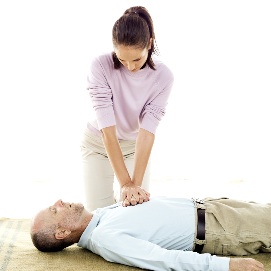




Emergency & First Aid » Emergency Procedures


Hands Only CPR
This is giving chest compressions with no rescue breaths. It can be used for adults only who suddenly collapse in places outside-the-hospital setting. Hands-Only CPR is not for
-
•All infants and children.
-
•Adults who have collapsed due to near-drowning, a drug overdose, or breathing problems.
-
•Adults who are already unconscious and not breathing normally when found.
Hands-Only CPR – 2 Steps:
-
1.Call 9-1-1 or get someone else to call!
-
2.Push hard and push fast in the center of the chest. Give 100 compressions per minute, such as to the tune of “Staying Alive” by the Bee Gees. (See step 1 on this page.) Keep this up, with minimal breaks, until an automated external defibrillator (AED) is used or EMS arrives.
CPR with Rescue Breaths for Adults and Children Over 8 Years Old
{Note: For adults, Hands-Only CPR is advised for persons not trained in CPR. Take a training course in CPR to learn how to do it the right way. Find out about training from the American Heart Association at www.heart.org/HEARTORG.}
Shout for help! Call or have someone else call 9-1-1 and get an automated external defibrillator (AED) if one is nearby. Follow the 9-1-1 dispatcher’s advice. Until the AED is used or EMS provides care, do CPR.
Video
Ken Jeong suits up in the American Heart Association's new Stayin' Alive video to promote Hands-Only CPR.


-
2.Open the person’s airway. With one hand, tilt the person’s head back. With 2 fingers of your other hand, lift the chin up. If the airway is blocked, tilt the person’s head gently and slowly until the airway is open.
If the person is not breathing, take a normal, not a deep breath, and give him or her Rescue Breaths:
-
•Pinch the nose shut. Forming a tight seal, place your mouth over the person’s open mouth.
-
•Give 1 full breath for 1 second. If the chest doesn’t rise, repeat head tilt chin lift. Give the 2nd full breath for 1 second. Look to see if the person’s chest rises.
Give cycles of 30 chest compressions and 2 rescue breaths, without a break, until the person starts to move, an AED is used, or EMS provides care.


-
1.Begin Chest Compressions:
-
-Kneel at the person’s side. Place the heel of one hand 1/2 inch above where the ribs join the breastbone. Place your other hand on top of this hand. Using the heels of your hands, depress the middle of the chest between the nipples at least 2 inches. Keep your arms straight.
-
-Push hard and push fast! Give at least 100 chest compressions in one minute. Relax pressure after each compression.

CPR for Children Ages 1 to 8 Years Old
Shout for help! If you are alone, do CPR for 2 minutes before you call 9-1-1. If the child does not appear to have a serious injury, carry the child to nearest phone and call 9-1-1! Put the phone on speaker mode. Follow the dispatcher’s advice. If you are not alone, someone start CPR; someone else call 9-1-1 and get an AED, if one is nearby.
-
1.Place the child on his or her back.
-
2.Start Chest Compressions:
-
-Put one hand on the child’s breastbone right between his or her nipples.
-
-Using the heel of your hand, push straight down about 2 inches. Let the chest rise back up after each push.
-
-Push hard and push fast! Give about 100 chest compressions in one minute. Relax pressure after each compression.
-
3.Follow steps 2, 3, 4, and 5 under CPR with Rescue Breaths for Adults and Children Over 8 Years Old.
{Note: Chest compressions alone are better than doing nothing, but it is best to give chest compressions plus rescue breaths. Why? Airway problems are the main cause of cardiac arrest in infants and children.}
CPR For Babies Up to 1 Year Old
-
1.If you are alone, do CPR for 2 minutes before you call 9-1-1. If the child does not appear to have a serious injury, carry the child to nearest cell or other phone and call 9-1-1! Put the phone on speaker mode. Follow the dispatcher’s advice. If you are not alone, someone start CPR; someone else call 9-1-1!
-
2.Start Chest Compressions:
-
-Put the tips of your middle and ring fingers on the baby’s breastbone right between his or her nipples.
-
-Slip your other hand underneath the baby’s back for support.
-
-Push straight down about 1½ inches. Push at a rate of 100 times in one minute. Let the chest rise back up after each push.
-
3.If the baby is not breathing, or you are not sure he or she is breathing, give 2 rescue breaths:
-
-Cover the infant’s mouth and nose with your mouth, forming a tight seal.
-
-Give 1 full breath for 1 second. Look to see if the chest rises. Give the 2nd full breath for 1 second and look to see if the chest rises.
-
-If the chest does not rise, go back to giving chest compressions. {Note: If you can’t give rescue breaths, just keep giving chest compressions.}
-
4.Give cycles of 30 chest compressions and 2 rescue breaths, without a break. Do this until the baby starts to move or until EMS provides care.
Resources




This video explains the changes in the new 2010 Guidelines for CPR released on October 18. We're making CPR even easier so more people will perform it and more lives will be saved. For more information visit www.heart.org/cpr.

2012 © All Rights Reserved - American Institute for Preventive Medicine | Disclaimer | Phone: 800.345.2476 | www.HealthyLife.com


